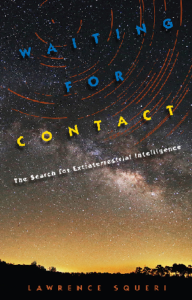News
Waiting for Contact
Posted on October 27, 2016
Waiting for Contact: The Search for Extraterrestrial Intelligence
by Lawrence Squeri
 Imagine a network of extraterrestrials in radio contact with each other across the universe, superior beings who hail from advanced civilizations quadrillions of miles away, just waiting for Earth to tune in. Some people believe it’s only a matter of time before we discover the right “station.”
Imagine a network of extraterrestrials in radio contact with each other across the universe, superior beings who hail from advanced civilizations quadrillions of miles away, just waiting for Earth to tune in. Some people believe it’s only a matter of time before we discover the right “station.”
Waiting for Contact tells the story of the Search for Extraterrestrial Intelligence (SETI) movement, which emerged in 1959 as astronomers began using radio telescopes to listen for messages from space. New technological developments turned what once was speculation into science. Boosted by support from Frank Drake, Philip Morrison, Carl Sagan, and the genre of science fiction, the SETI movement gained followers and continues to capture imaginations today.
In this one-of-a-kind history, Lawrence Squeri looks at the people, reasons, goals, and mindsets behind SETI. He shows how it started as an expression of the times, a way out of Cold War angst with hope for a better world. SETI’s early advocates thought that with guidance from technically and ethically advanced outsiders, humanity might learn how to avoid horrors like nuclear annihilation and societal collapse from overpopulation. Some hoped that good news from outer space might reveal a cure for cancer or even the secret of immortality.
Squeri also describes the challenges SETI has faced over the years: the struggle to be taken seriously by the scientific community and by NASA, competition for access to radio telescopes, perpetual lack of funding, and opposition from influential politicians. He covers the rise and fall of Soviet SETI and the few rare meetings between Soviet and American astronomers.
Despite many setbacks, the movement pressed forward with the aid of private donations and developed outreach programs. Volunteers can now help search for new civilizations on their personal computers by joining the SETI@Home project. Today, SETI researchers continue to see themselves as explorers. They often identify with Columbus, and just as Columbus never realized the full implications of his discovery, we cannot predict what will happen if contact is made.
This book points out that if, against all expectations, the embattled SETI movement finally succeeds, the long-awaited first signal picked up by its radio antennas will usher the greatest shift in human history. A new adventure will begin.

